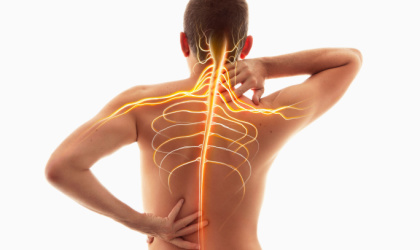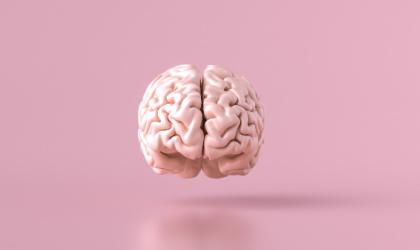
The nervous system is the conductor of our bodily symphony. It allows us to experience the world in all its richness and complexity – feeling the warmth of the sun on our skin, tasting the sweetness of a strawberry, and experiencing the thrill of a rollercoaster ride. We are nothing without it.
What is the nervous system?
The nervous system transmits signals between the brain and the rest of the body, including internal organs (1). It governs much of how we feel and what we think, as well as what our bodies do. It enables us to convey opinions, drive cars, play musical instruments, react to danger, show empathy to others, and so much more.
The basic unit of the nervous system is a neuron, or nerve cell (2). The brain has billions of neurons, each performing different jobs. When your brain receives a message from anywhere in the body, it responds with how to react.
For example, when you touch a hot stove, the nerves in your skin send discomfort signals to the brain. The brain then communicates to the muscles in your hand to move away. Fortunately, this relay race happens quickly to prevent you from injury.
Nervous system organs
The nervous system is comprised of the brain, spinal cord, and nerves (3). These organs consist of different tissues, including blood, nerve, and connective tissues. These areas of the body execute the sophisticated activities of the nervous system.
Nervous system functions
The nervous system controls and regulates different bodily functions with precision. These include (4):
-
Movement and balance
-
Intelligence, learning, memory, emotions and mental health
-
Bodily senses, like touch, smell, taste, hearing, and sight
-
Basic bodily functioning, such as breathing, digestion, sweating, and heart rate
Divisions of the nervous system
Structurally, the nervous system is made up of two parts: the central nervous system (CNS), containing the brain and spinal cord, and the peripheral nervous system (PNS), including all nerves running from the brainstem and spinal cord (5).
Central nervous system (CNS)
As the body’s processing centre, the central nervous system consists of the brain and spinal cord, both of which are protected by bone. The brain is a hub of neuronal activity; it governs movement, thinking, speech, and the five senses (6).
The spinal cord, meanwhile, serves as an extension of the brain, carrying messages to and from the brain via the network of peripheral nerves connected to it.?
You can read more about the central nervous system here.
Peripheral nervous system (PNS)
The peripheral nervous system connects the brain and spinal cord to the extremities of the body (7). The PNS communicates information to your brain from most of your senses.?
Learn more about the peripheral nervous system here.
Autonomic nervous system (ANS)
The peripheral nervous system is further subdivided into the autonomic nervous system. The ANS consists of three parts: the sympathetic, parasympathetic, and enteric (8).
The sympathetic nervous system controls the ‘fight or flight’ responses in the body, preparing the body for sudden stress, such as running from danger. The parasympathetic nervous system does the opposite, regulating ‘rest and digest’ functions once the emergency has passed. The enteric nervous system, meanwhile, governs the gastrointestinal tract.
The ANS oversees many physiological processes you rarely think about, including breathing, heart rate, body temperature, blood pressure, and other visceral activities (9).
Discover more about the autonomic nervous system here.
Natural support for the nervous system
There are numerous ways to keep your nervous system healthy. Prioritising sleep, reducing stress, exercising regularly, and eating a balanced wholefood diet are some of the best ways to keep this intricate and delicate system in check. Drinking in moderation and avoiding smoking are equally important.
Learn more about looking after your nervous system, naturally, here.
What vitamins support the central nervous system?
In addition to following a nutritionally rich diet, the nutrients below can help provide targeted support for your nervous system.
B vitamins
The B vitamin family is essential for many biochemical processes. Among these, vitamins B1, B3 (niacin), B6, B7 (biotin), and B12 support the nervous system. Find them: Green leafy vegetables.
To give your nervous system an extra helping hand, we recommend our high-strength B-complex, Neuro-B. This all-in-one formula is designed with healthy nerves in mind and contains relevant amounts of vitamin B1 for the nervous system, vitamin B6 (as PSP) for normal red blood cell formation, and B12 for normal neurological and psychological formation.
Iodine
Iodine is an important trace mineral needed in small quantities to support health. Crucially, iodine supports normal nervous system function. Find it: Prunes.
Magnesium
An essential mineral involved in over 300 biochemical processes; magnesium contributes to the normal functioning of the nervous system. Find it: Pumpkin seeds.
Vitamin C
Aside from immune health, vitamin C also plays a vital role in supporting nervous system function. Find it: Goji berries.
Vitamin D3
Vitamin D3 is critical for good health. Some experts believe low levels may affect the nervous system (10). Find it: Eggs yolks.
Omega-3
The long-chain omega 3 fatty acids, EPA (eicosapentaenoic acid) and DHA (docosahexaenoic acid) are important to overall health. Perhaps most notably, DHA contributes to the maintenance of normal brain function.* Find it: Oily fish or plant-based microalgae.
* A beneficial effect is obtained with a daily intake of 250mg of DHA
Adaptogenic herbs
Adaptogenic herbs, like Ashwagandha, Siberian Ginseng, and Korean Ginseng, are often recommended to restore balance in the body (11).
Palmitoylethanolamide
PEA is an endocannabinoid-like compound found in almost every cell, tissue, and fluid in the body. Naturally produced when cells are damaged or threatened, PEA is a well-researched alternative to CBD. It’s a popular choice to support wellbeing and nervous system function.
Theanine
The amino acid found in tea, theanine, is a useful addition for nervous system function and emotional health.
Turmeric
The active compound in turmeric, curcumin, has been celebrated for generations. Many people take it to support their overall health and wellbeing (12).
Want to learn more?
If you want to find out more about supporting your nervous system, please explore the rest of Nutrition Buzz. Alternatively, please get in touch with our team of expert Nutrition Advisors, who are on hand to provide free, confidential advice via email, phone, and Live Chat.**
**Subject to cookie consent
References:
-
Horton, J., Zimmermann, K.A. and Bradford, A. (2023) The nervous system: Facts, function and diseases, LiveScience. Purch. Available online: https://www.livescience.com/22665-nervous-system.html
-
Brain basics: The life and death of a neuron (no date) National Institute of Neurological Disorders and Stroke. U.S. Department of Health and Human Services. Available online: https://www.ninds.nih.gov/health-information/public-education/brain-basics/brain-basics-life-and-death-neuron
-
What are the parts of the nervous system? (2018) Eunice Kennedy Shriver National Institute of Child Health and Human Development. U.S. Department of Health and Human Services. Available online: https://www.nichd.nih.gov/health/topics/neuro/conditioninfo/parts
-
Nervous system: What it is, types, symptoms (2020) Cleveland Clinic. Available online: https://my.clevelandclinic.org/health/articles/21202-nervous-system
-
How does the nervous system work? (2009). National Center for Biotechnology Information. Available online: https://www.ncbi.nlm.nih.gov/books/NBK279390/
-
Horton, J., Zimmermann, K.A. and Bradford, A. (2023) The nervous system: Facts, function and diseases, LiveScience. Purch. Available online: https://www.livescience.com/22665-nervous-system.html
-
Jasvinder Chawla, M.D. (2023) Peripheral Nervous System Anatomy, Overview, Gross Anatomy, Microscopic Anatomy. Medscape. Available online: https://emedicine.medscape.com/article/1948687-overview
-
Anatomy, autonomic nervous system - statpearls - NCBI bookshelf (2023). Available online: https://www.ncbi.nlm.nih.gov/books/NBK539845/
-
Low, P. (2023) Overview of the autonomic nervous system - brain, spinal cord, and nerve disorders, MSD Manual Consumer Version. MSD Manuals. Available online: https://www.msdmanuals.com/home/brain,-spinal-cord,-and-nerve-disorders/autonomic-nervous-system-disorders/overview-of-the-autonomic-nervous-system/
-
Wrzosek M, ?ukaszkiewicz J, Wrzosek M, Jakubczyk A, Matsumoto H, Pi?tkiewicz P, Radziwo?-Zaleska M, Wojnar M, Nowicka G. (2013) Vitamin D and the central nervous system. Pharmacol Rep. 65(2):271-8.
-
Panossian A, Wikman G. (2010) Effects of Adaptogens on the Central Nervous System and the Molecular Mechanisms Associated with Their Stress-Protective Activity. Pharmaceuticals (Basel). 19;3(1):188-224.
-
Kulkarni SK, Dhir A. (2010) An overview of curcumin in neurological disorders. Indian J Pharm Sci. 72(2):149-54.
Related Posts

Olivia
Olivia Salter has always been an avid health nut. After graduating from the University of Bristol, she began working for a nutritional consultancy where she discovered her passion for all things wellness-related. There, she executed much of the company’s content marketing strategy and found her niche in health writing, publishing articles in Women’s Health, Mind Body Green, Thrive and Psychologies.
View More






